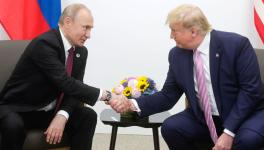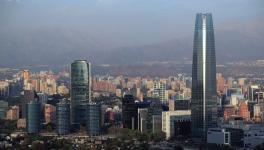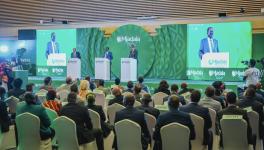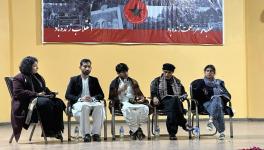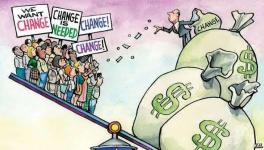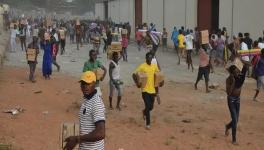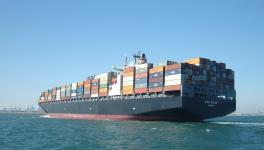Free Market Economy in Syria: We’ve Seen This failure Before
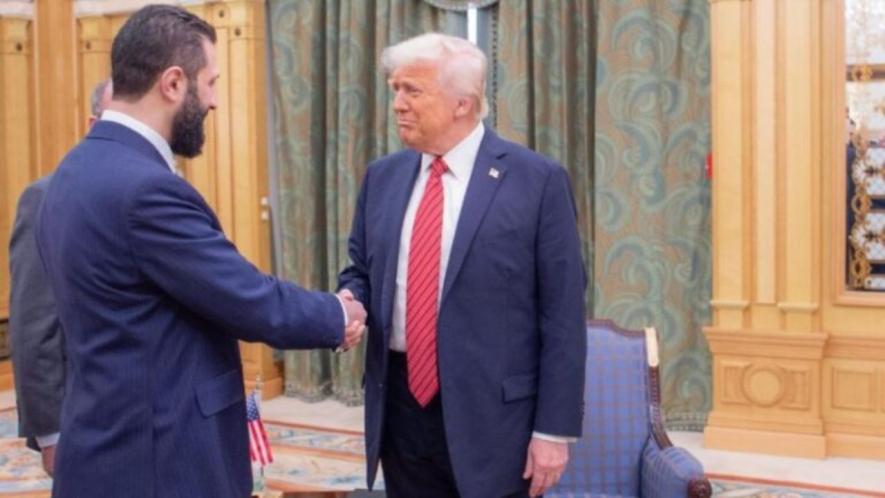
A meeting between Syrian President Ahmad al-Shara, US President Donald Trump, and Saudi Crown Prince Mohammed bin Salman in Riyadh on May 14. Photo: Al-Sharaa/X
Three days after rebel forces toppled President Bashar al-Assad’s regime, Bassel Hamwi, head of the Damascus Chamber of Commerce, told Reuters in an exclusive interview that the new economic model will be “a free market system based on competition.” Similarly, other high-ranking officials, including Syria’s Transitional President Ahmed al-Sharaa, noted that Syria has suffered from “socialist” economic policies. The advisor to the Minister of Economy stated: “The entire public sector must be sold,” illustrating that “establishing and managing businesses is the responsibility of citizens, not government bureaucrats who are amateur entrepreneurs.”
It is argued that such statements may be mere rhetoric meant to appease the international community without full implementation. However, a closer look at the new regime’s conduct since its arrival suggests that it has moved decisively toward extreme liberalization.
Despite the Baath regime’s decades-long history of a centralized, or “command” economy, where government bodies control production and distribution through state-owned enterprises, Assad shifted towards open market policies in the early 2000s. As a result, the public sector’s share of Syria’s GDP dropped to just one-third. The social consequences were disastrous, with some experts arguing that these policies played a key role in sparking the 2011 uprising. This raises critical questions about the new regime’s rationale for implementing similar policies, now on an even shakier foundation.
“Economic liberalization,” the contemporary meaning behind the oft-used term “free market economy,” refers to allowing businesses to take charge of the economy with minimal government restrictions. It is a model implemented through a standard international recipe which includes tax cuts for corporations, and privatization of public assets. This step implements harsh austerity measures, such as laying off public sector workers, cutting spending on public services, raising sales taxes, cutting pensions and ending subsidies on essential commodities. It also involves extreme facilitation of international trade, which can be to the detriment of domestic goods. These policies send a message to major financial institutions, like the IMF and World Bank, that a country is committed to making necessary changes to its fiscal policy in order to be eligible for financial aid. They also signal that the economy is open and attractive to foreign investors.
How is the new Syrian regime implementing a free market economy?
Since the beginning of the year, the government has unveiled a plan to overhaul the public sector by eliminating supposedly “ghost employees.” Former finance Minister Mohammad Abazid revealed in January that 400,000 “phantom names” must be purged from government payrolls, while the Minister of Administrative Development announced that Syria now needs only 550,000 to 600,000 public sector workers – less than half the previous workforce.
Additionally, Syria’s new government wasted no time in lifting state subsidies on fuel, raising diesel prices to nearly 10,000 Syrian pounds per liter at official gas stations in March 2025, compared to the subsidized rate of just 2,000 pounds in previous years. As a result, a taxi ride from Damascus to the suburbs costs half to almost all of a minimum-wage worker’s daily income.
In December 2024, beneficiaries of the “smart card system were denied subsidies on bread.” Families who used the card enjoyed the benefit of purchasing essential goods at reduced prices. Although the standard bundle now weighed 1,500 grams (up from 1,100 grams) and contained 12 loaves instead of just 7, this change came with a steep price increase, with the cost of a single bundle skyrocketing from 400 Syrian pounds to 4,000, marking a dramatic shift in the country’s approach to staples. On top of that, the Director General of the Syrian Bakeries Institution, Mohammad al-Sayyadi disclosed that the relevant authorities are currently conducting a study to either revise the price of the subsidized bread package or decrease its weight, as part of a broader strategy to gradually “liberalize” pricing.
Syria’s new government wasted no time in lifting state subsidies on fuel, raising diesel prices to nearly 10,000 Syrian pounds per liter at official gas stations in March 2025, compared to the subsidized rate of just 2,000 pounds in previous years.
To make matters worse, the state-run Syrian Trade Corporation was dismantled, its operations frozen, and its vast inventory liquidated through public auctions. This corporation was a merger of the General Consumer Corporation, the General Corporation for Storage and Marketing, and the General Corporation for the Distribution of Textile Products; it had direct sales links to citizens and state employees in most Syrian cities.
Trade liberalization took center stage, with the government promising to cut tariffs on imports by 60% within a month of its arrival. The administration also made efforts to remove trade and transportation barriers with neighboring Jordan and Turkey. Turkish exports to northern Syria surged to USD 219 million in January alone, marking a 35.5% year-on-year increase. Cheap Turkish products have now flooded the market and can be seen being bought on the sidewalks at the expense of Syrian goods. By the end of February 2025, Jordanian exports to Syria had surged by 483% compared to the same period in 2024, rising from 6 million to 35 million Jordanian dinars according to the Jordanian Department of Statistics, while Syrian exports to Jordan actually declined by 11.11%, from 9 million to 8 million dinars when comparing the first two months of 2024 and 2025.
Plans to revitalize Syria’s free trade zones with adjacent countries were also set in motion. The Jordan Free Zones Investors Commission reported that the total number of contracts signed in the Syrian-Jordanian Joint Free Zone has reached 88 investment and operational contracts since its reopening at the beginning of this year.
The new regime also implemented a policy of what can be described as “monetary austerity.” The central bank restricted liquidity, enforced strict withdrawal limits on bank accounts, and reduced the printing of new currency – measures that dampened consumer demand and weakened purchasing power. Notably, in May, the Central Bank of Syria announced that, starting July 5, clients would be allowed full withdrawals from new cash deposits made after May 7, 2025. However, the policy excludes remittances and earlier deposits, leading experts to view its impact as limited due to its narrow scope.
To fund the new free market economy, Sharaa engaged with a wide range of Syrian business figures, including wealthy investors, industrialists, and company executives, both domestically and abroad. He even established contact with former Assad-linked businessmen who had fled the country after the fall of the regime.
The central bank restricted liquidity, enforced strict withdrawal limits on bank accounts, and reduced the printing of new currency – measures that dampened consumer demand and weakened purchasing power.
The regime has promised businessmen from around the world to allow investment in strategic sectors of the Syrian economy, and Syrian officials have held meetings for this purpose with investors and officials from countries such as China, Turkey, Azerbaijan, not to mention European and Arab countries. On May 1, Syria signed its first major investment deal with a global corporation, a €230 million, 30-year contract with France’s CMA CGM to develop and operate the Port of Latakia, the country’s main seaport.
In order to secure and stabilize these investments, the regime pursued every possible avenue to lift sanctions, promising European countries to take back Syrian refugees, going to the Elysee Palace to get President Macron’s blessing, and even desperately trying to arrange a meeting with President Trump, going so far as to make symbolic gestures, such as proposing the construction of a Trump Tower in Damascus.
Lessons from Assad’s free market policies
It appears that the new regime has not learned the lessons of Assad’s liberalization plan in the decade leading up to the Syrian uprising in 2011. Bashar al-Assad’s aggressive push toward a free market economy is well documented in Mohammad Jamal Barut’s book “The Last Decade in Syria’s History: The Dialectic of Stagnation and Reform.”
Barut points out that liberalization was achieved through a sweeping wave of legislative and policy reforms, known as the Decree Revolution, which saw the introduction of over 1,200 new laws between 2000 and 2005. These reforms were designed to integrate the Syrian economy into global economic flows, benefit from Syrian capital, and take advantage of the financial boom in the Gulf region.
Syrian economist Jihad Yazigi points out that following Syria’s economic liberalization in the early 2000s, private investors took the reins and dominated almost every major sector of the economy. The private sector became the driving force behind agriculture, manufacturing, construction, wholesale and retail trade, tourism, domestic transportation, and more, not to mention new opportunities in energy and finance. Barut’s book shows how tangible these results have been: The private sector’s contribution to GDP rose from 59.8% in 2000-2005 to 64.9% in 2006-2009.
It is important to note that this economic liberalization came at the expense of industrialization, favoring high-return, high-yield activities in the services sector, with the benefits going largely to the country’s wealthiest elites.
The social consequences of the liberalization model were stark. The percentage of Syrians living below the poverty line rose from 11.4% (2.04 million people) in 2004 to 12.3% (2.36 million) in 2007. Inflation surged from 10% in 2006 to 15.15% in 2008, making that year the worst of the decade.
Employment trends underscored the severe impact of these policies. Between 2004 and 2008, Syria’s economy generated only 90,000 new jobs, a strikingly low figure reflecting an average employment growth rate of just 0.5% per year. In contrast, labor force projections indicated that the economy needed to expand employment at an annual rate of 3-4% to absorb new entrants into the job market.
It is important to note that this economic liberalization came at the expense of industrialization, favoring high-return, high-yield activities in the services sector, with the benefits going largely to the country’s wealthiest elites. Barut sums up the situation in the following passage:
“In the rush to attract investment at any cost and drive quantitative economic growth, institutional reform in Syria was reduced to a narrow, neoliberal economic program. The guiding principle was an overreliance on the ‘invisible hand’ of the market, with policymakers prioritizing growth rates over equitable distribution.”
Shaky foundations
Assad’s flawed liberalization plan came at a time when Syria’s political, economic, and social foundations were relatively stable, a time when a decade and a half of war didn’t make it a state of shaky foundations. Now, the new regime is attempting to implement a similar model, under far less favorable circumstances.
To give an idea of those shaky foundations, a recent UNDP report notes that in addition to massive infrastructure damage, the war in Syria has caused an estimated USD 800 billion in lost GDP over 14 years of conflict. Economic growth simulations suggest that if Syria continues to grow at the modest rate observed in recent years – about 1.3% annually between 2018 and 2024 – its GDP will not return to 2010 levels until 2080, nearly 55 years from now.
Therefore, the war has created inadequate conditions for investment in Syria, as the country’s “Investment Climate Combined Index” was 141.3 in 2023, placing the country at the bottom of the list at 154. The index is based on the findings, reports, and ratings of international companies and financial, investment and consulting institutions on the political, economic and institutional situation of countries in the region. Additionally, Syria ranked 116 in the Economic Performance Indicator, which is one of the sub-indices that make up the Investment Climate Index. In contrast, Barut points out that the Assad old plan for liberalizing the economy was very much linked to “the stability of the overall indicators of the Syrian macroeconomy that make up the investment climate combined index.”
A major challenge for the new regime lies in the lack of foreign currency reserves, a key requirement for a functioning free market based on supply and demand. In the decade when Assad embarked on his liberalization plan, the state had foreign currency reserves to finance about 29 months of imports, or 65% of the money supply, or 90% of 2005-2007 GDP. In comparison, the central bank’s foreign exchange reserves amount to only about USD 200 million in cash after the fall of the regime, as reported by Reuters, while another said the US dollar reserves were “in the hundreds of millions.”
What additionally encouraged the old government to pursue an open market policy at the beginning of the century was the stability of the exchange rate within limited fluctuations, while it now fluctuates continuously between the 10,000 and 12,000 levels, instead of being stable for years at the 14,700 level, as was the case before the fall of the previous regime.
Another reason why Sharaa’s liberalization plan is less robust than Assad’s is the fact that the poverty rate has nearly tripled, from 33% before the conflict to 90% today according to a UNDP report, while extreme poverty has increased sixfold, from 11% to 66%. This means that cutting public spending by leaving the prices of bread, medicine, and cooking gas to market mechanisms will make those products unaffordable for most Syrians.
In addition, what makes liberalization a challenge is the massive public debt that Syria has accumulated compared to its small economy, skyrocketing to USD 20 – 23 billion. These debt figures are high compared to a GDP of USD 17.5 billion in 2023, a fact that negatively affects the appetite of the foreign private for investing in Syria’s economy.
On the political level, Assad’s 25-year liberalization plans began in the era of a unified Syria and a centralized government that had full control over its territory. Today, the situation is markedly different, as Syria cannot offer a stable environment for investors amid continued violence by Islamist factions and targeted attacks on Alawites and Druze, alongside Israeli occupation and frequent incursions in the south. This persistent instability not only heightens the risk of asset damage and logistical disruptions but also reduces the number of active consumers in the market, further deterring investment.
Supporting local production can give citizens more money to spend by creating more jobs. This is a better way to boost purchasing power than simply making foreign goods cheaper by lowering trade barriers, which ultimately harms locally made products.
An alternative path
The alternative of “least state intervention in the economy” is to let the state play a central role in promoting the economy, and the alternative of relying primarily on capital and commodities from abroad is to promote national production.
According to Syrian economist Jihad Yazigi: “Rather than spending time showing the world that they can be as liberal as possible in their policy choices, the new Syrian authorities should focus on one long-term priority: increase domestic production in all business sectors.” The following actions become crucial: investing in infrastructure and safeguarding local producers from external competition to provide them with essential breathing room.
Supporting local production can give citizens more money to spend by creating more jobs. This is a better way to boost purchasing power than simply making foreign goods cheaper by lowering trade barriers, which ultimately harms locally made products.
This article was first published on Al Akhbar English.
Courtesy: Peoples Dispatch
Get the latest reports & analysis with people's perspective on Protests, movements & deep analytical videos, discussions of the current affairs in your Telegram app. Subscribe to NewsClick's Telegram channel & get Real-Time updates on stories, as they get published on our website.









